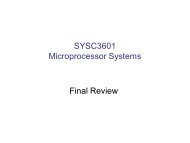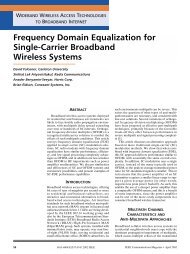Image Reconstruction for 3D Lung Imaging - Department of Systems ...
Image Reconstruction for 3D Lung Imaging - Department of Systems ...
Image Reconstruction for 3D Lung Imaging - Department of Systems ...
Create successful ePaper yourself
Turn your PDF publications into a flip-book with our unique Google optimized e-Paper software.
7.3 Evaluation Procedure<br />
A reconstruction algorithm that <strong>for</strong>mulates the inverse problem as in equation 7.34 and<br />
solves it as in equations 7.38 and 7.39 was developed in the MATLAB environment. The<br />
method proposed by Chan et al [31] to solve equation 7.35 assumes the <strong>for</strong>ward operator<br />
to be linear. The reconstructions that we present in this section <strong>of</strong> the paper are fully<br />
non-linear, the algorithm is shown to work on the cases we used as tests, but we do not<br />
provide a pro<strong>of</strong> <strong>of</strong> convergence.<br />
Evaluation was per<strong>for</strong>med by comparing the per<strong>for</strong>mance <strong>of</strong> the TV PD-IPM algorithm<br />
with that <strong>of</strong> the quadratic algorithm equation 7.3. In equation 7.3 L = RHPF where<br />
RHPF is the Gaussian spatial high pass filter originally described in [4]. 2D Simulated<br />
data were computed on a 1024 element circular mesh using the two phantoms shown in<br />
figures 7.3(a) and 7.3(b). Phantom A is a single “blocky” contrast with a conductivity<br />
(a) Phantom A (b) Phantom B<br />
(c) Phantom C<br />
Increasing σ<br />
Figure 7.3: 2D Phantom contrasts on a 1024 element mesh, used to generate simulated data<br />
using 16 electrode adjacent current injection protocol.<br />
<strong>of</strong> 0.90, phantom B consists <strong>of</strong> 2 “blocky” contrasts with conductivities <strong>of</strong> 0.90 and 1.10.<br />
Phantom C has a single contrast whose conductivity varies linearly from 1 at the edge to<br />
1.6 at the centre. 15 sets <strong>of</strong> reconstructions were made <strong>for</strong> phantoms A and B <strong>for</strong> each<br />
algorithm (TV regularization and ℓ 2 Gaussian regularization) with increasing amounts <strong>of</strong><br />
simulated noise added. 15 reconstructions were made <strong>of</strong> phantom C without adding noise.<br />
The 16 electrode adjacent protocol was used [4]. 2D reconstructions were per<strong>for</strong>med on a<br />
576 element circular mesh, not matching the mesh used <strong>for</strong> <strong>for</strong>ward computations, in order<br />
to avoid what is referred as an inverse crime [122].<br />
7.4 Results<br />
7.4.1 Phantom A<br />
Figure 7.4(a) and 7.4(b) shows that after the first iterative step the TV and the quadratic<br />
solutions are similar. The resolution, in terms <strong>of</strong> blur radius, is slightly better <strong>for</strong> the TV<br />
solution, however visual inspection <strong>of</strong> figures 7.4(a) and 7.4(b) shows that the TV solution<br />
has more noise. Blur Radius (BR) is defined as a measure <strong>of</strong> the resolution: BR = � Az/A0<br />
where A0 is the area <strong>of</strong> the entire 2D medium and Az is the area <strong>of</strong> the reconstructed<br />
contrast containing half the magnitude <strong>of</strong> the reconstructed image [4]. BR calculates the<br />
area fraction <strong>of</strong> the elements that contain 50% <strong>of</strong> the total image amplitude. We call this the<br />
half amplitude (HA) set. The convergence behaviour <strong>of</strong> the two algorithms is illustrated<br />
in Figure 7.5 in which Residual Error, Total Variation, and Resolution are plotted against<br />
105





